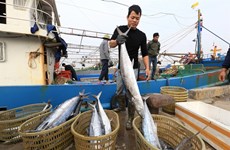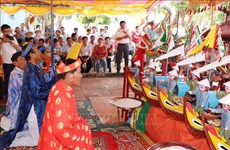Gap between city, rural internet use widens
Though Vietnam ranks among the top 20 countries for access to the
internet, there remains a widening gap between users in urban and rural
areas, IT experts said.
Though Vietnam ranks among the top 20 countries for access to the
internet, there remains a widening gap between users in urban and rural
areas, IT experts said.
According to the Vietnam Internet Association (VIA) around 30 million out of nearly 90 million people in the country use the internet. Yet, most internet subscribers are concentrated in cities.
Association president Vu Hoang Lien attributed the situation to internet service providers not understanding and failing to meet farmers’ needs.
“Many farmers still do not know the benefits of the internet,” he said, adding, “Some believe the internet to be less interesting than TV game shows.”
Association vice president Nguyen Long said he was not worried by infrastructure and internet connection equipment in Vietnam .
It was the content that service providers should utilise to attract farmers who account for over 70 percent of the country’s population, he said.
Recent years have seen programmes bring computers and internet access to rural and mountainous areas free of charge.
Yet, Long said, there remained little relevant content for farmers.
“So what is the point of bringing computers?” was the question posed to participants at a recent workshop entitled “The Future of Internet in Vietnam ” in Hanoi .
IT experts at the workshop agreed that the explosion of the internet in recent years mainly centred on entertainment services and on-line games, while practical content that served farmers, like training and health information were almost neglected.
Deputy General Director of Dong Duong Telecom Pham Van Chien said due to limitations in foreign language proficiency among farmers it was important to encourage the use of Vietnamese language in internet contents.
Deputy Director of the Vietnam Internet Network Information Centre Tran Minh Tan said it was essential to customise information on the internet as much as possible by using Vietnamese domains.
He cited the name of an on-line newspaper VnExpress that many farmers usually typed it wrong. Using Vietnamese domains would help farmers connect more, Tan said.
Other internet service providers called upon the VIA to build more content in Vietnamese to prevent farmers from having to access foreign websites.
Earlier, Long said while many companies were willing to supply equipment and infrastructure to rural and mountainous areas for free, others remained indifferent to the programme.
Director of FPT Telecom Corporation’s Northern Infrastructure Development Centre, Nguyen Cong Toan said telecom enterprises like FPT, Viettel and Vietnam Post and Telecommunications Group (VNPT), had a relatively similar internet coverage strategy nation-wide.
Yet, they had not worked together to build content, each still working for itself, he said.
Chien of Dong Duong Telecom, meanwhile, said transmission lines and internet connection equipment were also important in addition to content.
He said wireless technology would be the most suitable solution for rural and mountainous areas. The State and private enterprises must supply wireless access to help farmers reach beyond their homes, Chien added.
Association president Vu Hoang Lien stressed a need for educational and entertainment resources to farmers. He said these areas would attract attention to other aspects like health and the application of science and technology in agriculture.
He cited the case of farmer Dang Vu Dai in Central Highlands Gia Lai province’s Kim Nang hamlet whose family has become one of the most successful in the region thanks to the applications of knowledge supplied by the internet to agricultural cultivation.
About his experience, Dai recalled he found much of the advice on-line “absurd” compared to traditional farming methods.
“Yet, I persisted and applied the advice fearlessly,” he remembered.
Dai has become a “lecturer” and guided other farmers in his hamlet on how to apply the internet to their production./.
According to the Vietnam Internet Association (VIA) around 30 million out of nearly 90 million people in the country use the internet. Yet, most internet subscribers are concentrated in cities.
Association president Vu Hoang Lien attributed the situation to internet service providers not understanding and failing to meet farmers’ needs.
“Many farmers still do not know the benefits of the internet,” he said, adding, “Some believe the internet to be less interesting than TV game shows.”
Association vice president Nguyen Long said he was not worried by infrastructure and internet connection equipment in Vietnam .
It was the content that service providers should utilise to attract farmers who account for over 70 percent of the country’s population, he said.
Recent years have seen programmes bring computers and internet access to rural and mountainous areas free of charge.
Yet, Long said, there remained little relevant content for farmers.
“So what is the point of bringing computers?” was the question posed to participants at a recent workshop entitled “The Future of Internet in Vietnam ” in Hanoi .
IT experts at the workshop agreed that the explosion of the internet in recent years mainly centred on entertainment services and on-line games, while practical content that served farmers, like training and health information were almost neglected.
Deputy General Director of Dong Duong Telecom Pham Van Chien said due to limitations in foreign language proficiency among farmers it was important to encourage the use of Vietnamese language in internet contents.
Deputy Director of the Vietnam Internet Network Information Centre Tran Minh Tan said it was essential to customise information on the internet as much as possible by using Vietnamese domains.
He cited the name of an on-line newspaper VnExpress that many farmers usually typed it wrong. Using Vietnamese domains would help farmers connect more, Tan said.
Other internet service providers called upon the VIA to build more content in Vietnamese to prevent farmers from having to access foreign websites.
Earlier, Long said while many companies were willing to supply equipment and infrastructure to rural and mountainous areas for free, others remained indifferent to the programme.
Director of FPT Telecom Corporation’s Northern Infrastructure Development Centre, Nguyen Cong Toan said telecom enterprises like FPT, Viettel and Vietnam Post and Telecommunications Group (VNPT), had a relatively similar internet coverage strategy nation-wide.
Yet, they had not worked together to build content, each still working for itself, he said.
Chien of Dong Duong Telecom, meanwhile, said transmission lines and internet connection equipment were also important in addition to content.
He said wireless technology would be the most suitable solution for rural and mountainous areas. The State and private enterprises must supply wireless access to help farmers reach beyond their homes, Chien added.
Association president Vu Hoang Lien stressed a need for educational and entertainment resources to farmers. He said these areas would attract attention to other aspects like health and the application of science and technology in agriculture.
He cited the case of farmer Dang Vu Dai in Central Highlands Gia Lai province’s Kim Nang hamlet whose family has become one of the most successful in the region thanks to the applications of knowledge supplied by the internet to agricultural cultivation.
About his experience, Dai recalled he found much of the advice on-line “absurd” compared to traditional farming methods.
“Yet, I persisted and applied the advice fearlessly,” he remembered.
Dai has become a “lecturer” and guided other farmers in his hamlet on how to apply the internet to their production./.












